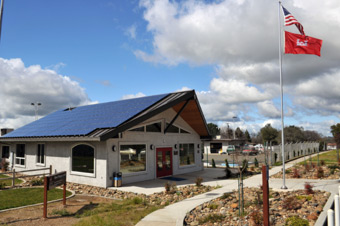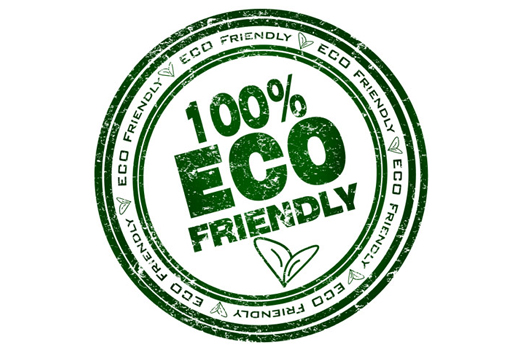U.S. Army Corps of Engineers: Strategic Sustainability Performance Plan
The U.S. Army Corps of Engineers (USACE) has joined other Federal agencies in developing plans to meet expanded sustainability requirements to lead the way in creating a clean energy economy. President Obama’s Executive Order (EO) 13514: Federal Leadership in Environmental, Energy and Economic Performance intends for Federal agencies to increase national prosperity, promote energy security, protect the interests of taxpayers and safeguard the health of the environment. The Corps of Engineers’ new Strategic Sustainability Performance Plan (SSPP) establishes ambitious goals representing the Agency’s commitment to implementing sustainability and EO 13514.
These goals are:
- Reduce scope 1 and 2 greenhouse gas emissions through energy and fuel efficiency and renewable energy. (Scope 1 are emissions from sources owned or controlled by a Federal agency, and scope 2 result from generation of electricity, heat or steam purchased by a Federal agency.)
- Reduce scope 3 greenhouse gas emissions. (Scope 3 are emissions from sources not owned or directly controlled by a Federal agency but related to agency activities.)
- Develop and maintain a comprehensive greenhouse gas inventory.
- Implement “Guiding Principles for Federal Leadership in High Performance and Sustainable Buildings.”
- Engage in regional and local sustainable planning efforts to achieve sustainable communities.
- Improve water use efficiency and management.
- Prevent pollution and waste.
- Improve sustainable acquisition practices.
- Improve electronic stewardship practices, including energy efficiency at data centers.
- Implement innovative sustainable practices related to core mission areas.
Creating a Systems-Based Approach
Commitment to sustainability is not new for the Corps of Engineers. The Agency introduced a set of Environmental Operating Principles in March 2002 making sustainability its first principle: “Strive to achieve environmental sustainability. An environment maintained in a healthy, diverse and sustainable condition is necessary to support life.” USACE also has supported the Army’s Triple Bottom Line of Sustainability Plus: Mission, Environment, Community and Economic Benefit. In addition, sustainability is a basic tenet of one of four main goals in the Corps of Engineers’ Campaign Plan unveiled in 2008. Goal 3 mandates the USACE to deliver innovative, resilient, sustainable solutions to the Armed Forces and Nation.
| The new, co-located headquarters of the U.S. Army Forces Command and U.S. Army Reserve Command, whose construction is being overseen by the U.S. Army Corps of Engineers Savannah District, taking shape at Fort Bragg, N.C., incorporates numerous energy and resource saving features to meet Leadership in Energy and Environmental Design (LEED) Silver standards. |
 © U.S. Army photo by Jim Hinnant, FORSCOM-PA |
What is new, however, is having specific sustainability goals and targets, and taking a systems-based, continual improvement approach to accelerate its sustainability program. This includes working to train personnel and to develop and refine priorities, programs and metrics. To date, USACE sustainability actions have resulted in a robust set of effective independent actions. The new challenge is to bring these independents actions together in a holistic, focused and comprehensive way, and the SSPP provides the framework to do just that.
Sustainability in the Corps of Engineers breaks down into two lines of operation: fulfilling sustainability obligations within the Command’s internal infrastructure and operations, and continuing to provide services, advice and support to enable customers to reach their sustainability goals. Therefore, the Agency is committed to ensuring its customers receive products and services that support sustainable solutions, which address short– and long-term environmental, social and economic considerations.
Reflective of these two operational lines, the Corps of Engineers’ SSPP is separate from the Department of Defense’s (DoD) SSPP. Under Secretary of the Army Dr. Joseph Westphal designated Jo-Ellen Darcy, Assistant Secretary of the Army for Civil Works, as Senior Sustainability Officer for the Corps of Engineers. Westphal cited the Agency’s unique missions (Civil Works, Military Programs and Research and Development) and its different appropriation sources as basis for his decision for USACE to develop its own SSPP. The organization developed its SSPP in coordination with the Assistant Secretary of the Army (Installations, Energy and Environment) and the Office of the Deputy Under Secretary of Defense (Installations and Environment) to ensure consistent understanding of those aspects of the Agency’s mission that are more appropriately addressed in the DoD SSPP.
Having a separate Strategic Sustainability Performance Plan is both a challenge and an opportunity. Fundamentally, the challenges are the same as what the Corps of Engineers would face if it fell under the DoD SSPP – establishing a program and management system to meet ambitious sustainability targets within complex missions. However, a separate SSPP is an opportunity to add an additional level of accountability and transparency to energize workforce innovations and to show leadership in the Federal community. Having its own Strategic Sustainability Performance Plan provides the Corps of Engineers an excellent chance to demonstrate publically its long-standing commitment to sustainability relative to EO13514 requirements and associated Federal goals.
Integrating through Operations
USACE faces many challenges in the coming years as it strives to achieve EO13514 sustainability goals. The primary one will be operationalizing sustainability by making it an integral part of the Agency’s corporate business processes. This includes developing budgets and mission-specific business practices, and operation and maintenance of its facilities and vessels.
Leadership within the Corps of Engineers is an important key in managing these challenges and opportunities. The new Strategic Sustainability Committee (USACE SSC), chaired by the Corps’ Deputy Commanding General, was initiated at the end of fiscal year 2010. The committee is comprised of senior leaders from functional areas of the Corps of Engineers’ headquarters, divisions, districts, laboratories and field activities, thus demonstrating that all levels of the Agency’s command structure are actively engaged. The committee works closely with Darcy to ensure the Corps of Engineers is on target to meet its SSPP goals. Supporting USACE SSC is the Energy Governance Council, chaired by the Deputy Commanding General for Military and International Operations, which is charged with overseeing and coordinating energy activities within the Corps of Engineers.
 Illustration by James Jennings |
This illustration captures ideas from members of the U.S. Army Corps of Engineers when asked to envision what a government headquarters building may look like in the future with multiple, sustainable technologies and initiatives in use. |
Examples of how USACE has embraced sustainability can be found across the Agency, again building upon its Environmental Operating Principles. The Corps of Engineers uses the U.S. Green Building Council’s Leadership in Energy and Environmental Design (LEED) standards in military construction projects, with the USACE requiring a minimum LEED Silver status. LEED Gold certification has been achieved on several projects. For example, USACE is on track to make the Washington, D.C., metro Headquarters Services facility – a 1.6 million-square-foot office structure being built as part of the Base Realignment and Closure Act – a LEED Gold certified building. It will use 50 percent less water than a traditional building of the same size and will include motion-activated LED lighting. Regarding recycling and reusing, trees removed from the construction site are being re-used in the building’s landscape. Plans also are under way to achieve LEED Platinum status on military installations at several other facilities.
In addition, the Corps of Engineers is identifying and costing energy and sustainability enhancements for five standard building types on military installations, looking at impacts of climate change and sea-level changes on facilities, and thinking “greener” and more efficiently in all operations. In fiscal year 2010, USACE’s Center for the Advancement of Sustainability Innovations (see livebetter’s Jan/Feb 2011 issue) completed four studies to characterize water, energy, waste and operational requirements of forward operating bases. And, it’s beginning a research effort to create a “virtual forward operating base” with scalable solutions to integrate energy, water, waste, security and operations.
USACE Louisville District is replacing its fleet of vehicles with hybrids, with 11 received thus far, and 12 more are on the way. And, the Agency is working with National Oceanic and Atmospheric Administration (NOAA) to investigate converting selected vessels in the Corps’ floating plant to biodiesel (B100), with plans to test B100 on five vessels before the end of May, including the motor vessel Pathfinder in the St. Louis District.
At Fort Irwin, Calif., work on a deployable renewable energy power station is under way. Its remote, off-grid facilities include solar, wind and conventional generator technologies, battery storage and power conditioning not only to provide reliable power but also to reduce operation and maintenance costs. A USACE recreation area outside Pittsburgh is powered by solar panels to reduce energy use, and park rangers there are using the panels as part of a program to educate visitors on renewable energy.
Empowering for Public Welfare
But, there’s more to be done. This includes improving efficiencies in future facilities and vehicles; installing compact florescent and LED light bulbs in workplaces; driving less, driving more fuel-efficient vehicles and increasing use of alternative-fueled vehicles; improving water use efficiency and management; and improving sustainable acquisition practices.
| The New Hogan Lake Park Headquarters facility is operating a solar electricity system. New Hogan is one of nine U.S. Army Corps of Engineers Sacramento District park and dam operation offices to install solar systems. Such systems help put USACE on the road to sustainability. |
 U.S. Army Corps of Engineers photo |
Critical to the Corps of Engineers’ success is empowering its employees to take personal responsibility for ensuring the Agency meets its sustainability goals. Changing individual behaviors is an essential first step in achieving sustainability goals. That means taking small steps, such as turning off lights when not in use, scheduling and participating in webinars when practical in place of temporary duty travel, using power strips specifically designed to reduce excess energy usage, telecommuting, carpooling, using public transportation and reducing overall water and energy consumption.
As a result of population growth and increased perils caused by strained energy supplies, environmental pressures and other negative impacts due to climate change, sustainability is not just a “buzzword” anymore. It’s a path to meeting future challenges while creating new opportunities.
Future sustainability priorities for the Corps of Engineers for fiscal year 2011-12 include:
- Establishing baselines and effective data collection systems
- Conducting energy and water audits at 25 percent of covered facilities
- Implementing sustainable energy, fuel and water efficiency technologies
- Modernizing hydropower facilities to increase generation and use of renewable energy
- Assessing and identifying opportunities within the vehicle fleet
- Repowering selected vessels
- Targeting renovation projects for compliance with “Guiding Principles”
- Increasing data center energy efficiency
- Operationalizing climate change adaption through pilot projects
With a mission to provide vital public engineering services in peace and war to strengthen the Nation’s security, energize the economy and reduce risks from disasters, the Corps of Engineers must contribute to national welfare and serve the public by providing quality and responsive services to the Nation, the Army and other customers. It is imperative this be accomplished in a manner that is environmentally, economically and socially sustainable, and that focuses on public safety and collaborative partnerships. Embracing sustainability will help the Corps of Engineers do that, especially if it’s made a natural part of all decision-making processes and part of the organization’s culture.
For more information about the U.S. Army Corps of Engineers’ sustainability efforts, visit: www.usace.army.mil/sustainability.





























